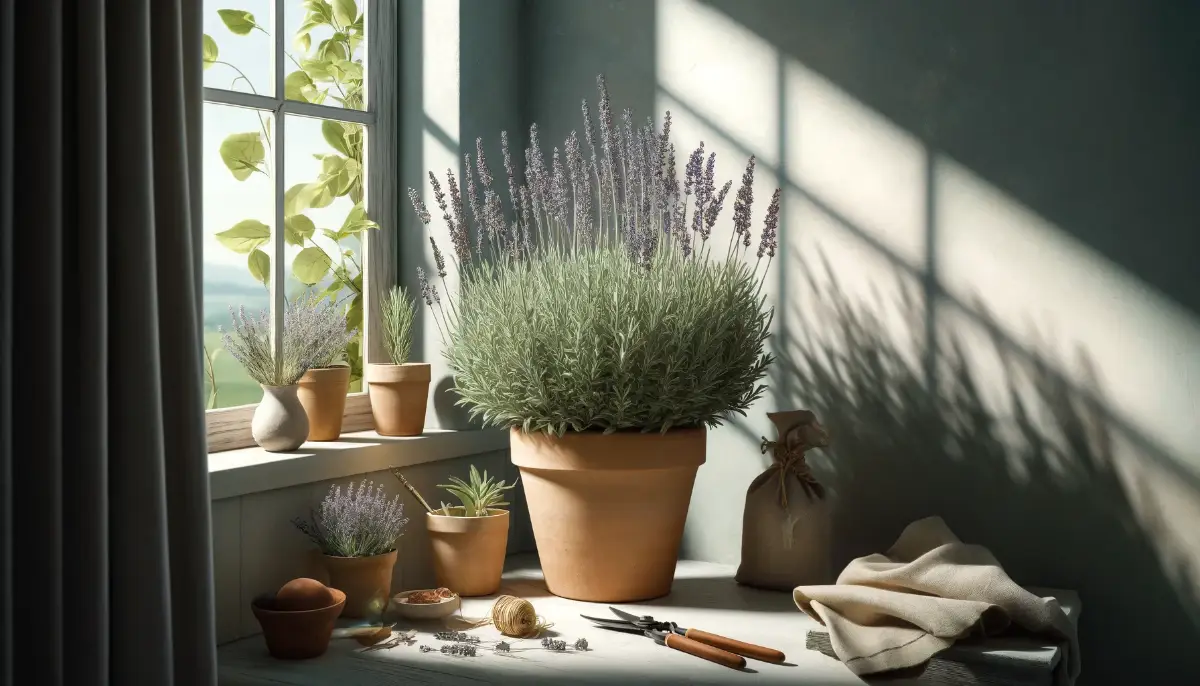Growing lavender indoors enriches your space with a splash of color and a fresh, calming fragrance.
This versatile herb, known for its soothing properties and culinary uses, can thrive inside with the right care.
Whether you’re a seasoned gardener or a novice, understanding how to nurture lavender will ensure it flourishes, bringing a touch of the Mediterranean to your home.
Understanding Lavender’s Basic Needs
Soil and Potting
Lavender prefers lean, slightly alkaline soil with excellent drainage. You can achieve the right pH by adding a tablespoon of limestone to your potting mix.
Avoid using materials that retain too much water like coconut coir or sphagnum peat moss. Instead, mix in extra sand or perlite for better drainage. When repotting, select a pot only 1-2 inches larger in diameter than the root ball, as lavender thrives when slightly crowded.
Terracotta pots are ideal because they allow for good air movement and quick drying of the soil.
Light Requirements
Lavender needs lots of light to flourish, so place it in a south-facing window where it can get a minimum of three to four hours of direct sunlight daily. If natural light is insufficient, consider using an LED grow light. Rotate the pot weekly to ensure uniform growth.
Lavender does not fare well in extreme cold or under direct heat from heaters in winter. During the colder months, it’s better to keep it in a cooler room that still gets some sunlight.
Watering and Humidity
Water your lavender deeply but infrequently, allowing the soil to dry out between waterings. Over the spring and summer, water a little more often to support growth.
Reduce watering frequency in the fall and winter when the plant’s growth slows down. Be careful to avoid getting water on the leaves or flowers, as this can promote fungal diseases
Temperature and Air Circulation
Maintain cooler temperatures in the winter to mimic lavender’s dormant period and warmer temperatures during the growing season. Ensure good air circulation around your plants to prevent pest infestations and diseases.
Avoid placing your lavender near cold drafts or heat sources.
Pruning and Harvesting
Prune your lavender after the first flowering to encourage bushy growth and again in the fall. You can harvest lavender flowers in early spring just after they open.
To dry them, cut long stems, tie them in bundles, and hang them upside down in a dry place for about four to five weeks
Propagation
Lavender can be propagated from cuttings to expand your collection. Use a 4-inch stem cutting, remove the leaves from the bottom, and plant it in moist potting soil. Alternatively, you can grow lavender from seedlings, though this method requires more patience.
Choosing the Right Variety
When growing lavender indoors, opt for dwarf or compact varieties like Canary Island lavender or Fern leaf lavender. These are more suitable for container growing and will thrive better indoors.
When and How Often to Fertilize
Organically fertilizing lavender indoors focuses on mimicking the plant’s natural preference for low-nutrient, well-drained soils. Lavender thrives in conditions that resemble its native Mediterranean environment, where soils are not rich in organic matter.
Read also: How to Make Fertilized at Home
Here are some guidelines for organically fertilizing your indoor lavender:
- Basic Fertilization: Lavender generally requires little to no fertilization. However, a basic application of organic fertilizer in the early spring (March or April) can benefit the plant by providing essential nutrients for the initial growth phase.
- Additional Fertilization for Potted Plants: For lavender growing in pots, a second application of fertilizer in early summer (end of June or beginning of July) is recommended to support optimal growth throughout the season.
Organic Fertilization Methods
- Compost: A single application of compost in late autumn or early spring is sufficient for most indoor lavender plants. This method supplies a balanced mix of nutrients while improving soil structure and health.
- Manure: If using manure, apply sparingly, as lavender does not respond well to high nitrogen levels. Excessive nitrogen can lead to lush foliage at the expense of flowers and may increase the plant’s susceptibility to pests and diseases.
- Avoid Mulching with Organic Materials: Organic mulches like grass clippings retain moisture and can lead to conditions unfavorable to lavender, such as root rot.
- Commercial Organic Fertilizers: If homemade compost or manure is not available, commercial organic fertilizers are a good alternative. Look for products that offer a slow release of nutrients, mimicking the gradual nutrient availability in lavender’s natural growing conditions.
NPK Ratio (nitrogen, phosphorus and potassium)
- Balanced Fertilizer: A balanced NPK ratio (e.g., 12-12-12) is suitable for promoting overall plant health, including root development, foliage growth, and blooming. Adjust the ratio based on whether you want to encourage more foliage or flowers.
- Application Method: Apply granular organic fertilizer directly to the soil, ensuring even distribution around the base of the plant. Avoid contact with the foliage to prevent burn injuries.
Additional Tips
- Soil pH: Lavender prefers slightly alkaline soil. If your indoor potting mix is too acidic, consider adding garden lime to adjust the pH level to lavender’s preference (between 6.5 and 8).
- Watering After Fertilizing: After applying fertilizer, water the plant well to help dissolve and distribute the nutrients through the soil.
Organic fertilization of indoor lavender is straightforward and requires minimal intervention, reflecting the plant’s hardy nature and low nutrient needs. Focus on creating a growing environment that resembles its natural habitat for the best results.
Benefits of growing lavender indoors
Growing lavender indoors offers a multitude of benefits, from its aromatic fragrance to various health and culinary advantages. Here’s a summary of the key benefits:
Aromatic Ambiance – Lavender’s brilliant scent can make your home more inviting and help you feel more relaxed and calm. It’s known for its ability to improve mood and create a soothing environment.
Health and Wellness – Lavender has notable health benefits, especially in skin care, where it’s used to reduce inflammation, lighten skin complexion, and treat skin conditions like psoriasis and eczema. It’s also beneficial for treating hair loss, relieving migraine headaches, and promoting wound healing thanks to its antifungal and antibacterial properties.
Improves Sleep Quality – Lavender oil is widely recognized for its ability to fight insomnia and promote better sleep quality without the side effects associated with prescription sleep aids. A few drops of lavender oil on your pillow or a pouch of lavender under your pillow can help enhance sleep quality.
Natural Insect Repellent – The fragrance of lavender, while pleasant to humans, is effective at repelling many common household pests, including ticks, gnats, mosquitos, and moths. This makes lavender a great natural alternative to chemical insect repellents.
Stress Relief – Lavender’s calming scent is also believed to help reduce anxiety, relieve migraines, and alleviate psychological stress. Its aroma can relax the nerves and boost overall wellbeing.
Culinary Uses – Lavender’s flowers and foliage can be used in cooking, particularly in desserts like sponge cakes and chocolates, as well as infused into lemonades and alcoholic drinks. Its unique flavor adds a delightful twist to many recipes.
Easy to Care For – Lavender is low-maintenance and ideal for gardening beginners. It doesn’t require much water, making it easy to grow in containers and pots. This simplicity in care makes it a popular choice for indoor gardening.
Medicinal Uses – Beyond its calming effects, lavender essential oils are used in a variety of skin care products and for aromatherapy, offering therapeutic benefits that enhance personal wellbeing.
FAQs about Growing and Caring for Lavender indoors
Can lavender thrive indoors?
Yes, lavender can grow indoors successfully if provided with enough light—around 6-8 hours of bright sunlight per day—and well-drained soil. It also benefits from the occasional use of LED grow lights to supplement natural sunlight.
How often should I water indoor lavender?
Lavender prefers to be watered sparingly. It’s drought-resistant and susceptible to root rot from overwatering. A good rule of thumb is to water when the top inch of the soil feels dry to the touch.
What type of pot is best for growing lavender indoors?
A terracotta pot is recommended for growing lavender indoors due to its porosity, which allows the soil to dry out more efficiently between waterings. Ensure the pot is only 1-2 inches larger than the plant’s root ball for optimal growth.
How can I ensure my indoor lavender gets enough light?
Place your lavender near a south-facing window to ensure it receives a minimum of 6-8 hours of direct sunlight. If you lack sufficient natural light, supplement with an LED grow light.
What are the benefits of growing lavender indoors?
Growing lavender indoors offers numerous benefits, including improving air quality, providing a soothing aroma, offering culinary and medicinal uses, and adding aesthetic appeal to your indoor space.
What soil pH is ideal for indoor lavender?
Lavender thrives in slightly alkaline soil with a pH between 6.7 and 7.3. You can adjust the pH by adding builder’s sand and lime to your potting mix.
When and how should I prune my indoor lavender?
Prune your lavender after the first flowering and again in the fall to encourage bushy growth and prevent the plant from becoming woody. Harvest the flowers in early spring just as they open for drying.
Can I propagate lavender indoors?
Yes, you can propagate lavender by taking cuttings from an existing plant. The best time to take cuttings is after the plant blooms. Remove the leaves from the bottom of the stem and plant them in a light, well-draining soil mix.
How do I fertilize indoor lavender?
Lavender prefers nutrient-poor soil, so it requires minimal fertilization. If necessary, use a slow-release or liquid organic fertilizer sparingly to avoid overfeeding.
How can I use lavender harvested from my indoor plant?
Lavender can be used in various ways, including in homemade soaps, lotions, culinary dishes, and for its aromatic properties to improve relaxation and sleep quality. You can also dry the flowers for long-term storage.









